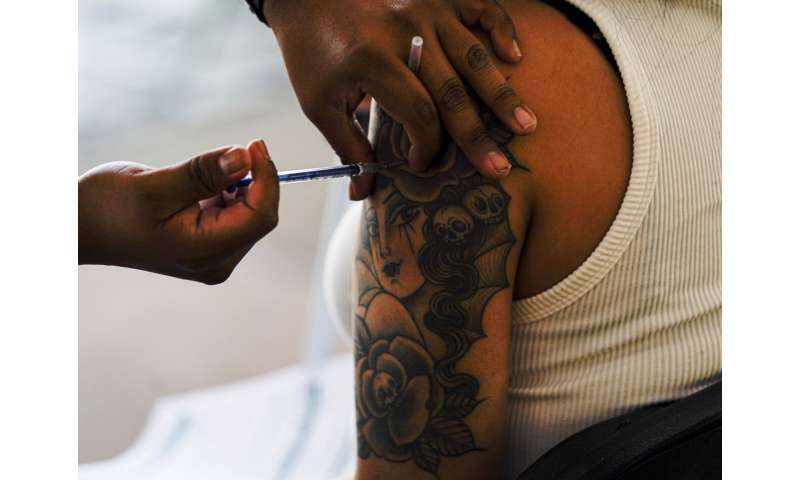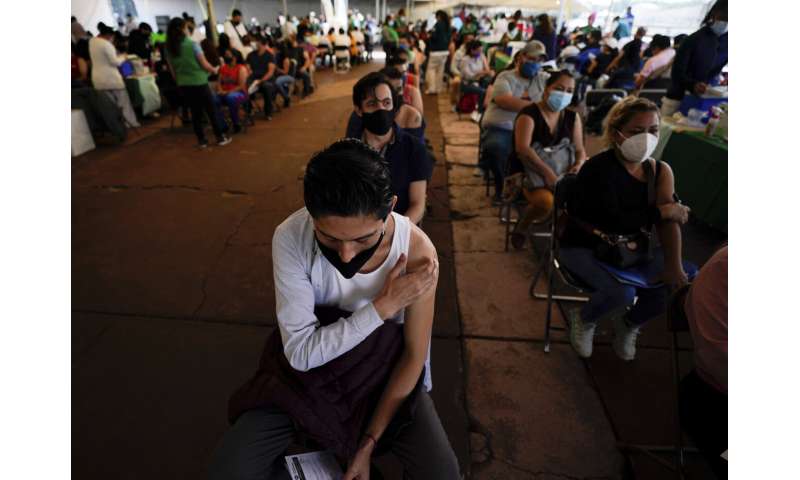Youth focus of COVID-19 infections in Mexico’s 3rd wave

Hours after Mexico City authorities raised the capital’s COVID-19 alert level in the face of surging infections, especially among young people, residents packed a plaza on a pleasant evening in the charming Coyoacan borough.
Among them was Mario Estrada Flores, a lanky 21-year-old college student, who along with nine friends—all without masks—started up an impromptu rap performance that drew dozens of applauding onlookers.
“I’m not worried about getting infected because I’m young,” Estrada Flores said. “I have more defenses than an older person … we have the idea that since we’re young nothing bad is going to happen to us or if we do get it it’s not going to be so strong.”
Specialists say that attitude is common in Mexico’s youth, a population that is driving the increase in infections in the country’s third pandemic wave.
Mexico has registered 2.75 million confirmed infections and more than 238,000 COVID-19 deaths, both figures the government concedes are significant undercounts. The country’s death total places it behind only the United States, Brazil and India.
Throughout the pandemic, Mexico President Andrés Manuel López Obrador has resisted imposing strict lockdowns seen in other countries or limiting travelers arriving from abroad. His government opted for a rapid expansion of hospital beds to treat COVID-19 patients, recognizing early on that much of the population had to leave home every day to work and feed their families.

The number of new infections has been rising since mid-June and is now up more than 40%, according to government figures. But unlike the last spike in cases in December and January, hospitalizations, and especially deaths, have been rising much more slowly.
Assistant Health Secretary Hugo López-Gatell said Tuesday that the number of infections were about 37% higher than Mexico’s first wave, but still had not reached the heights of its second. He said mortality was 77% lower than during the first wave and 87% lower than the second.
“The potential of this epidemic is very large and it is growing very rapidly,” said Dr. Andreu Comas, a professor at the San Luis Potosi Autonomous University’s Medical School and Center for Health Science Research and Biomedicine. He said in the 29th week of Mexico’s pandemic, the country exceeded 16,000 daily infections, a figure 2.7 times larger than the same time last year.
Comas said this new wave could be far-reaching because “now it is hitting the bulk of the population which is the group between 16 and 55 years old.” That counts for half of Mexico’s 126 million residents.

“It is the population that moves the most because on one hand it is the country’s economic engine and on the other it is the population with the most social life,” he said.
The younger side of that group also remains largely unvaccinated, making them more vulnerable in this wave, said infectious disease expert Dr. Francisco Moreno Sánchez, of the ABC Medical Center in Mexico City.
This week, in an attempt to slow rising infections, the government added people 18 and over to those eligible for vaccinations. So far, about 42.4 million people have been vaccinated, according to the health ministry. That is about 47% of the adult population, but only about 30% of the total population, leaving many vulnerable, Moreno Sánchez said.
“Many of them are going to be infected, they are going to have to be hospitalized and there is no system that can help control this,” Moreno Sánchez said.

The Delta variant is another factor in this most recent surge in cases, as it has been in much of Latin America. It is far more contagious and has a shorter incubation period, Moreno said.
The San Luis Potosi Autonomous University has said it is present in at least 23 of Mexico’s 32 states.
López Obrador downplayed the threat of the latest wave, saying that it would be “less damaging” than the first two, “because we have fewer hospitalizations and most importantly, fewer deaths.”
The president ruled out closing stores or other businesses, saying the government would not “exaggerate with authoritarian measures” because “we all already know how to take care of ourselves.” López Obrador was infected with the virus in January.
On Tuesday, the president revealed that his 14-year old son Jesús Ernesto had recently been infected. He said they had been together, because they didn’t know he was infected because “it doesn’t hit adolescents hard.” He said neither he nor his wife had problems because they were vaccinated.

López Obrador said he shared that information to calm fears and remind people that the vaccines have demonstrated their effectiveness.
Authorities will focus on expanding the vaccination campaign because there is no other option for facing the virus, he said.
During a break in the rap performance, while some of his friends danced to reggaeton in the plaza, Estrada Flores, a first year student in administration, conceded that being out without a mask “is a little ignorant on our part because we’re taking a risk and we have older relatives, and we also put them at risk.”
While some of his friends don’t trust the vaccines, he said he was open to getting it, because “it’s better to take care of ourselves, because of the older people we have at home.”
Across the city, Alejandro Carrillo, a 28-year-old doctor, was in a small bar drinking beer and dancing salsa with 20-some others, all without masks.



“I had not gone out, but now I’m vaccinated,” Carrillo said by way of explanation. He said infections were rising because “people are overconfident.”
Source: Read Full Article



